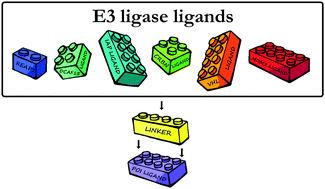E3 ligase ligand chemistries: from building blocks to protein degraders†
Abstract
In recent years, proteolysis-targeting chimeras (PROTACs), capable of achieving targeted protein degradation, have proven their great therapeutic potential and usefulness as molecular biology tools. These heterobifunctional compounds are comprised of a protein-targeting ligand, an appropriate linker, and a ligand binding to the E3 ligase of choice. A successful PROTAC induces the formation of a ternary complex, leading to the E3 ligase-mediated ubiquitination of the targeted protein and its proteasomal degradation. In over 20 years since the concept was first demonstrated, the field has grown substantially, mainly due to the advancements in the discovery of non-peptidic E3 ligase ligands. Development of small-molecule E3 binders with favourable physicochemical profiles aided the design of PROTACs, which are known for breaking the rules of established guidelines for discovering small molecules. Synthetic accessibility of the ligands and numerous successful applications led to the prevalent use of cereblon and von Hippel–Lindau as the hijacked E3 ligase. However, the pool of over 600 human E3 ligases is full of untapped potential, which is why expanding the artillery of E3 ligands could contribute to broadening the scope of targeted protein degradation. In this comprehensive review, we focus on the chemistry aspect of the PROTAC design process by providing an overview of liganded E3 ligases, their chemistries, appropriate derivatisation, and synthetic approaches towards their incorporation into heterobifunctional degraders. By covering syntheses of both established and underexploited E3 ligases, this review can serve as a chemistry blueprint for PROTAC researchers during their future ventures into the complex field of targeted protein degradation.

- This article is part of the themed collection: Modalities of induced proximity pharmacology: Degraders and Beyond themed collection


 Please wait while we load your content...
Please wait while we load your content...